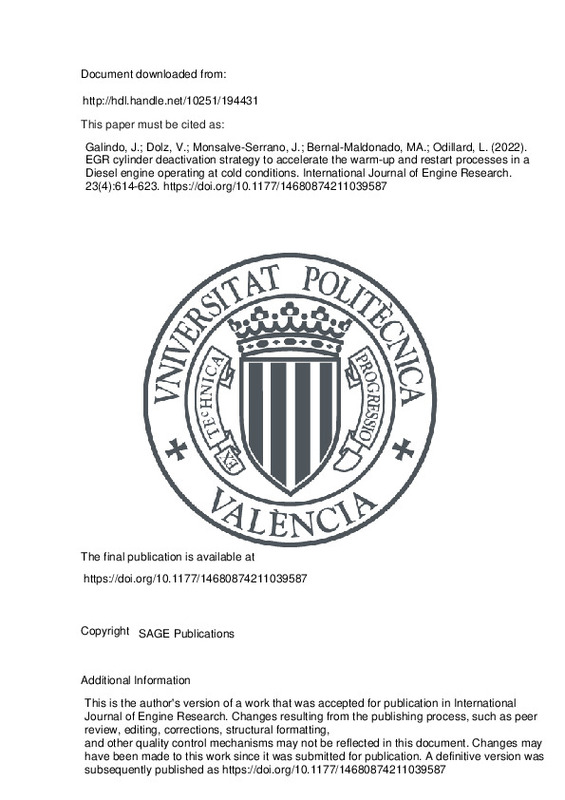Galindo, J.; Dolz, V.; Monsalve-Serrano, J.; Bernal-Maldonado, MA.; Odillard, L. (2022). EGR cylinder deactivation strategy to accelerate the warm-up and restart processes in a Diesel engine operating at cold conditions. International Journal of Engine Research. 23(4):614-623. https://doi.org/10.1177/14680874211039587
Por favor, use este identificador para citar o enlazar este ítem: http://hdl.handle.net/10251/194431
|
Título:
|
EGR cylinder deactivation strategy to accelerate the warm-up and restart processes in a Diesel engine operating at cold conditions
|
|
Autor:
|

 Galindo, José
Galindo, José

 Dolz, Vicente
Dolz, Vicente

 Monsalve-Serrano, Javier
Bernal-Maldonado, Miguel Angel
Odillard, Laurent
Monsalve-Serrano, Javier
Bernal-Maldonado, Miguel Angel
Odillard, Laurent
|
|
Entidad UPV:
|
Universitat Politècnica de València. Escuela Técnica Superior de Ingeniería del Diseño - Escola Tècnica Superior d'Enginyeria del Disseny
|
|
Fecha difusión:
|
|
|
Resumen:
|
[EN] The aftertreatment systems used in internal combustion engines need high temperatures for reaching its maximum efficiency. By this reason, during the engine cold start period or engine restart operation, excessive ...[+]
[EN] The aftertreatment systems used in internal combustion engines need high temperatures for reaching its maximum efficiency. By this reason, during the engine cold start period or engine restart operation, excessive pollutant emissions levels are emitted to the atmosphere. This paper evaluates the impact of using a new cylinder deactivation strategy on a Euro 6 turbocharged diesel engine running under cold conditions (-7 degrees C) with the aim of improving the engine warm-up process. This strategy is evaluated in two parts. First, an experimental study is performed at 20 degrees C to analyze the effect of the cylinder deactivation strategy at steady-state and during an engine cold start at 1500 rpm and constant load. In particular, the pumping losses, pollutant emissions levels and engine thermal efficiency are analyzed. In the second part, the engine behavior is analyzed at steady-state and transient conditions under very low ambient temperatures (-7 degrees C). In these conditions, the results show an increase of the exhaust temperatures of around 100 degrees C, which allows to reduce the diesel oxidation catalyst light-off by 250 s besides of reducing the engine warm-up process in approximately 120 s. This allows to reduce the CO and HC emissions by 70% and 50%, respectively, at the end of the test.
[-]
|
|
Palabras clave:
|
EGR
,
Cylinder deactivation
,
Cold conditions
,
IC engine
,
Warm up
,
Exhaust catalyst activation
|
|
Derechos de uso:
|
Reserva de todos los derechos
|
|
Fuente:
|
International Journal of Engine Research. (issn:
1468-0874
)
|
|
DOI:
|
10.1177/14680874211039587
|
|
Editorial:
|
SAGE Publications
|
|
Versión del editor:
|
https://doi.org/10.1177/14680874211039587
|
|
Código del Proyecto:
|
info:eu-repo/grantAgreement/UPV//PAID-01-17//Contratos Pre-Doctorales UPV 2017- Subprograma 1/
|
|
Descripción:
|
This is the author's version of a work that was accepted for publication in International Journal of Engine Research. Changes resulting from the publishing process, such as peer review, editing, corrections, structural formatting,
and other quality control mechanisms may not be reflected in this document. Changes may have been made to this work since it was submitted for publication. A definitive version was subsequently published as https://doi.org/10.1177/14680874211039587
|
|
Agradecimientos:
|
The author(s) disclosed receipt of the following financial support for the research, authorship, and/or publication of this article: Authors want to acknowledge the support of "Programa de Ayudas de Investigacion y Desarrollo ...[+]
The author(s) disclosed receipt of the following financial support for the research, authorship, and/or publication of this article: Authors want to acknowledge the support of "Programa de Ayudas de Investigacion y Desarrollo (PAID-01-17) de la Universitat Politecnica de Valencia''.
[-]
|
|
Tipo:
|
Artículo
|







![[Cerrado]](/themes/UPV/images/candado.png)


